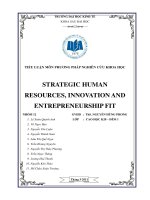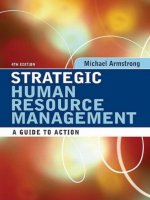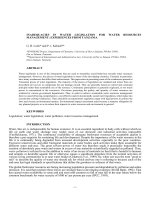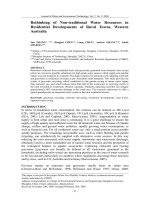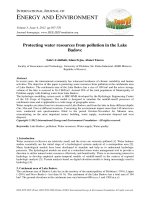Mineral resources
Bạn đang xem bản rút gọn của tài liệu. Xem và tải ngay bản đầy đủ của tài liệu tại đây (3.13 MB, 29 trang )
Energy Resources
Nuclear Power - Uranium
•
•
•
•
•
Uranium (U) – used for nuclear power
Has a Minimum Concentration Factor > 1000
Source Rock – Igneous
U is leached (dissolved) into groundwater
Deposit Types
– Sandstones that have been enriched with U minerals
(groundwater enrichment)
– U-bearing minerals in rock fractures
– Placer Deposits
Hydroelectric and
Tidal Power
• Movement of water
drives turbines
• Dams – gravity key force
• Tidal – tidal force, need a
tidal range of > 8 m
(nearly impractical)
Geothermal
Energy
• Temperature increases
with depth ~ 3oC/ 100 m
• Geothermal energy
concentrated where
magma is near the surface
• Circulation of groundwater
allows water to heat up
• Hot groundwater drives
turbines
Mineral Resources
Daily Questions
• Within your groups, identify one task you
all have completed today. Collectively
think about the task and brainstorm.
Produce a list of all of the mineral resources
that were used in that task.
Some Important Minerals and there Uses
•
•
Galena [PbS] – source of lead – car batteries
Magnetite, Hematite [FexOy] – iron ore
•
Bauxite [Al2O3*2H2O] – aluminum ore
•
Chalcopyrite [CuFeS2] – copper ore
•
Quartz [SiO2] – glass and electronic components
•
Gypsum [CaSO4*2H2O] – sheetrock, plater of paris
•
•
Sphalerite [ZnS] – zinc ore
Calcite [CaCO3] – portland cement, soil conditioner, antacids
•
Garnet [Al2(SiO4)3+other metals] – abrasives
•
Olivine [(Fe,Mg)2SiO4] – silicon chips for computers
•
•
•
•
•
•
Sulfur [S] – insecticides, rubber tires, paints, papermaking, etc.
Halite [NaCl] – Table salt
Graphite [C] – lubricant, pencil lead
Feldspars [K,Ca,Na,Al, silicates] – porcelain, source of K
Any other element that is not a major component of a mineral
Gold [Au], Silver [Ag], Platinum [Pt], Titanium [ Ti], Tin [Sn], etc.
Reserves vs. Resources
• Reserves
– Natural resources that
have been discovered &
can be exploited
profitably with existing
technology
– Oil – 700 billion barrels
• Resources
– Deposits that we know
or believe to exist, but
that are not exploitable
today because of
technological,
economical, or political
reasons
– Oil – 2 trillion barrels
Degree of economic feasibility
High
Total Resources
Discovered
Undiscovered
Proven
Resources Hypothetical,
Known
speculative, Unconceived
resources
or inferred Resources
(located
resources
but not
measured)
Recoverable resources
(not likely to be economic
in foreseeable future)
Nonrecoverable resources
(present in the earth but not obtainable
with present technology)
Low
High
Degree of geologic assurance
Low
Potential
Economical
Threshold
Technological
Threshold
Limit of
crustal
abundance
Geochemically Abundant Elements
(GAE)
• Elements comprise > 0.1% (by
weight) of the crust
• Form as principal component
in minerals within common
rocks – i.e. iron (Fe) Fe2O3
• Form very large deposits
• Form rock deposits
Geochemically Scarce Elements
(GSE)
• Elements that comprise < 0.1% (by weight) of the
crust
• Do not form as principal component in minerals
within common rocks, usually occur as a
substitute in rock forming minerals
• Form small deposits
• Ore minerals include sulfides, native elements,
etc.
Will run out
Abundant
Mineral Deposits
• Elements need to be concentrated
• Minimum Grade - minimum amount of element
necessary to economically mine element
• Minimum Concentration Factor (MCF) –
Minimum Grade divided by the Crustal
Abundance
– GAE have MCF < 100
– GSE have MCF > 100
Comparison of Concentrations of Elements in the
Earth’s Crust with Concentrations needed to operate
a Commercial Mine
Element
Natural
Concentration in
Crust (% by Weight)
Concentration Required
to Operate a commercial
mine (% by Weight)
Enrichment
Factor
Aluminum
8
24-32
3-4
Iron
5.8
40
6-7
Copper
0.0058
0.46-0.58
80-100
Nickel
0.0072
1.08
150
Zinc
0.0082
2.46
300
Uranium
0.00016
0.19
1200
Lead
0.00010
0.2
2000
Gold
0.0000002
0.0008
4000
Mercury
0.000002
0.2
100,000
Process that concentrate elements
• Igneous Processes
– Hydrothermal
– Magmatic
• Sedimentary Processes
– Mechanical
– Chemical
• Metamorphism Processes
• Groundwater Processes
Hydrothermal Processes
• Precipitation of metallic
ions from hot, ion-rich
fluid
• Fluid could be
– Magmatic
– Groundwater
– Oceanic water
• Magmas heat up the water
• Water flows into fractures,
faults, joints, etc. where it
cools and precipitates
(deposits) the metals
Magmatic Processes
• Gravity Settling
– Dense, early-crystallizing
minerals sink to the bottom
of the magma chamber
• Filter Pressing
– Tectonic force compress a
magma chamber and force
the still-liquid portion into
fractures, creating large
crystals
• These processes have
produced large bodies of
iron, chromium, titanium,
and nickel
Sedimentary Processes
• Clastic
– Weathering of
rock also weathers
out elements of
interest
– Generally, the
elements are heavy
and are deposited
when a streams
competence is
low.
– Placer deposits,
Placer Gold
Sedimentary Processes
• Chemical
Precipitates
– Water with high
concentrations of
elements is
evaporated
– Evaporation of
water leaves the
elements
– Ex. Salts, Iron,
etc.
Metamorphism
• Alteration of rock
concentrates the
elements
• The heat and
pressure force out
the GSE
(“impurities”)
Weathering
• Chemical weathering removes
soluble material.
• Ore material (elements of
interest) are left behind in a
concentrated residue.
Groundwater
• Secondary enrichment
• Groundwater dissolves and carries elements in
solution
• Chemical conditions change and the elements are
precipitated (deposited) out.
• Ex. Lead
Groundwater
• Secondary enrichment
• Groundwater dissolves and carries
insignificant elements in solution
• Insoluble elements of interest remain.
• Ex. Aluminum
Ore Mineral
• Ability to separate and readily process the
metal (element) from the ore material.
• Need to look at
– The energy to process the material
– The cost to process the material
– The value of the metal
• Basically, is it profitable to mine the metal?

